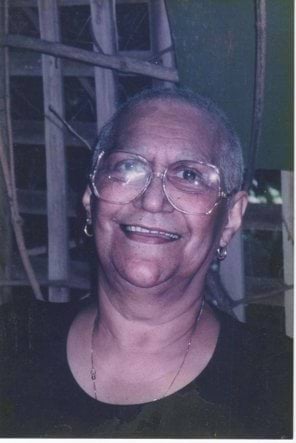
- Inducted:
- 2016
Clara Luttrell-Garisau, better known as Aunty Claire, devoted her life to improving outcomes for Aboriginal Victorians. Her active involvement in a number of movements, particularly those related to women and children and her championship of NAIDOC, earned her widespread respect affection amongst the Victorian Aboriginal community and beyond.
A proud Yorta Yorta woman, Clara was born in Echuca, the second eldest of Thomas and Mary (nee Hamilton) James’s 13 children. She was the grand-daughter of Shadrach James, an influential teacher who had taught future Aboriginal leaders such as William Cooper and Douglas Nicholls at Cummeragunja Aboriginal Reserve, across the border in New South Wales.
Cummeragunja walk-off in 1939
Clara spent her first few years at Cummeragunja Reserve before the family moved with their grandparents to Mooroopna and later to a house in Shepparton. Other James family members left the reserve during the 1939 ‘walk off’ in protest at the poor conditions and harsh treatment of the residents.
Clara’s parents instilled a strong work ethic in their children. As a young woman, she was a skilled cyclist who competed in local and regional competitions. She met and married Edward ‘Snowy’ Luttrell, a Tasmanian bricklayer, who was cycling around the mainland on a working holiday but got no further than Shepparton when he met Clara. They had 5 young children under the age of 7 when Edward died prematurely of pneumonia. With 5 children to support, Clara set about earning some qualifications. In 1963 she moved to Melbourne with her younger sister, Roma, to study nursing. The sisters were the first Aboriginal women to gain nursing qualifications at the Royal Melbourne Hospital.
Aboriginal nurses forging their path
While working as a nurse in Melbourne, Clara mixed with the growing Aboriginal community in and around Fitzroy, many of whom she had known since childhood. It was at this time that she met Fred Garisau, who would become her second husband. They eventually settled in West Heidelberg with Clara’s children - Michael, John, Janene, Peter and Paul. In 1973 Aboriginal activists established the Victorian Aboriginal Health Service (VAHS) in Gertrude Street Fitzroy. Clara became the first nurse at the service and was one of the team that canvassed Aboriginal people living in the inner city and the western suburbs on the need to establish a dental service. The VAHS Dental Service, established soon after, was the first community-controlled dental service in Australia.
Establishment of the Aboriginal Funeral Service
Clara joined with Aunty Edna Brown who was concerned that many in the Aboriginal community were unable to afford proper funerals or burials. Together they worked to raise money for a funeral fund, organising barbecues and cabaret nights at the Collingwood Town Hall. Their pioneering efforts led to the establishment of the Aboriginal Funeral Service.
Clara’s standing in the community was such that, in the mid-1970s, Pastor Sir Doug and Lady Gladys Nicholls requested that she become the manageress of the Gladys Nicholls Hostel, operated by the Aborigines Advancement League (AAL). Sir Doug and Lady Gladys had been behind the opening of the hostel in 1960, hoping to provide a safe and culturally supportive home for Aboriginal girls and young women, and later boys, coming to Melbourne for study or work.
Management of a hostel providing a safe place for Aboriginal youth
Clara managed the hostel for over 25 years, taking a caring but very firm hand with the young people for whom she was responsible. She was often on call to pick up young women who had been released from juvenile justice centres and bring them back to the hostel or to Margaret Tucker Hostel.
Despite having a full-time job at the hostel and a family of her own to care for, Clara continued to give to the community in a multitude of other ways. She was concerned by the domestic violence endured by many Aboriginal women. Together with Elizabeth Hoffman and Eleanor Harding, she worked to establish the Elizabeth Hoffman House (now called the Elizabeth Morgan House) which opened in the early 1970s. Clara was also well-known in the community for her role in raising the profile of NAIDOC as a celebration of Aboriginal history and culture and the achievements of Aboriginal and Torres Strait Islander peoples.
She chaired Victoria’s NAIDOC Committee for 25 years, advocating on behalf of the committee to the national body and distributing funds for NAIDOC Week celebrations each year to Victorian organisations. Clara was also a representative on the National NAIDOC Committee for 11 of those years. Her contribution to NAIDOC was recognised by a posthumous award from the National Committee in 2005.
For many members of the Victorian Aboriginal community, Clara’s crowning achievement was her organisation of the annual Miss NAIDOC contest and the NAIDOC Week Ball at the San Remo Ballroom in Carlton. She was determined that the ball would offer a memorable night at a cost that was affordable to as many people as possible. Her generosity in providing free tickets to those in need meant there was often some last minute reshuffling to fit everyone in on the night.
NAIDOC celebrates Aboriginal history, culture and achievements
Clara was also a Board member for a number of Aboriginal community controlled service organisations. She was a Chairperson and Board member of the Aboriginal Community Elders Service and a Board member of the Aborigines Advancement League, Victorian Aboriginal Health Service, Elizabeth Morgan House and the Margaret Tucker Hostel for girls.
Clara provided a positive role model of how to care for community
Known for her happy but forthright personality, Clara earned widespread respect for her heartfelt efforts to help her people. To her children, she provided a positive role model of how to care for community.
Sadly, she was taken by cancer shortly after her retirement from the Lady Gladys Nicholls Hostel in 1999. Her legacy lives on in the many community-run organisations that she helped to nurture and in her children, grandchildren and great-grandchildren.
Updated

